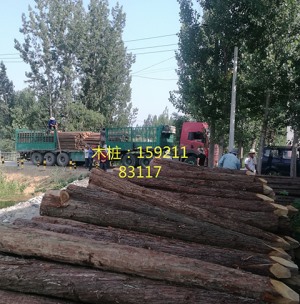Newly transplanted big trees have weakened resistance and are susceptible to natural disasters, pests and diseases, and man-made harm to livestock and poultry. Strict precautions must be taken. Next, the editor will tell you how to use fir stakes to protect the big tree:
1. Support: Due to the large crown, high center of gravity and small root system of large-scale trees, the tree itself cannot be fixed and is easily blown down or skewed by the wind. Even if the tree sways, the roots are likely to shake, making the roots unable to take root or causing damage. Dew will cause the roots to rot. Therefore, after the big tree is planted, it is necessary to support it. The support of the big tree usually uses fir stakes, which depends on the standard and height of the tree. In this project, the fir stakes generally use triangular or 4-corner shapes. Symmetrically supported, the bottom of the bamboo pole is fixed with short wooden stakes and supports to prevent it from sliding in the wind. The bamboo pole and the supporting part of the tree body are tied firmly with hemp rope. The supporting parts of the tree should be protected with brown leather or straw rope to avoid damage. After the bark is supported, shake the tree body vigorously. The tree body will be strong and will not sway.
2. Prevent diseases and pests: Adhere to the principle of focusing on prevention and combining prevention and treatment, and based on the characteristics of tree species and the occurrence and development patterns of pests and diseases, check frequently and do preventive operations. Once a disease occurs, it is necessary to prescribe the right medicine and prevent and control it in time.
3. Fertilizer: Fertilizer is beneficial to the recovery of tree vigor. In the early stage of transplantation of large trees, the root system has low fertility absorption, so it is advisable to use external fertilizer, usually once every half a month. Use quick-acting fertilizers such as urea, ammonium sulfate, and potassium dihydrogen phosphate. The fertilizer is prepared into a fertilizer solution with a concentration of 0.5 to 1 percent. Spray on the leaves in the morning and evening or on cloudy days. Spray again in case of rainfall. After the root system sprouts, the soil can be fertilized. It is required to apply thin fertilizer frequently to prevent damage to the roots. .
4. Antifreeze: The branches of newly planted large trees have late root germination, short annual growth cycle, and little accumulation of nutrients. Therefore, the tissue is not sufficient and they are susceptible to low temperature damage. Antifreeze and heat preservation work should be done well. On the one hand, after autumn, It is necessary to control nitrogen fertilizer, apply more phosphorus fertilizer and potassium fertilizer, and gradually extend the lighting time and increase the lighting intensity to improve the lignification degree of the tree and improve its own cold resistance. Secondly, before the cold wave of winter comes, the tree should be well insulated. Operation. You can protect it by covering it with soil, covering it on the ground, setting up wind barriers, building plastic greenhouses, etc.

Related Industry Knowledge
- Methods for preventing corrosion and discoloration of fir wood piles
- Uses of radiata pine logs imported from New Zealand
- How to construct round wood piles
- Correct method of pine pile construction
- Classification of larch wood pile tube holes and transverse, radial and chordal sections
- Precautions for using fir support poles
- How to choose fir wood piles
- The solution to piling fir wood piles in rivers
- Construction of fir wood pile rockery on revetment
- Greening fir pole uses
- The reason why cedar piles are widely used
- Construction method of pine piles
- How to identify the quality of fir wood piles
- The selection of fir wood piles should focus on quality
- Some issues you need to pay attention to when using pine piles
- How to keep fir wood piles fresh
- Is it necessary to take anti-corrosion measures for fir wood piles?
- How to properly construct pine piles



